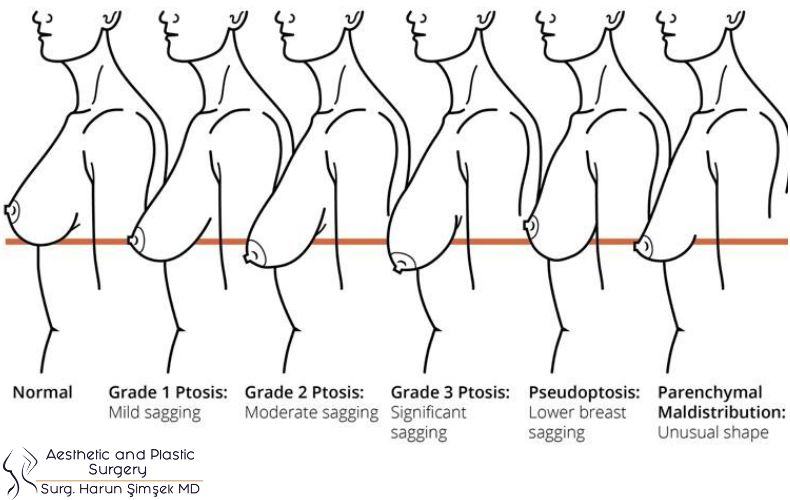
Why do boobs sag?
Due to their weight and gravitational pull, large breasts droop more rapidly, and sagging may be seen as early as adolescence. Some of the causes of drooping breasts include:
- Smoking,
- Obesity,
- Pregnancy,
- Breastfeeding
- Aging,
- Incorrect workout,
- Genetic influences,
- The gravitational pull of gravity,
- Hormonal factors,
- Putting on and losing too much weight,
- Breast tissue structure,
- Breast overuse, weakened ligaments supporting the breasts owing to congenital defects, exposure to too much sun, menopause-related breast tissue loss and relaxation,
- Silicone implants used for breast augmentation are some environmental factors.
What are the types of Breast Sagging?
"Breast Sagging" refers to the downward displacement of the nipple and its surrounding pink-brown region (nipple-areola) in relation to the breast fold line.
The nipple is located above the breast fold line in a typical breast. Between the nipple and the inframammary fold, the bottom pole of the breast has a little outward bend.
It is not, however, particularly baggy and loose. The degree of breast drooping is indicated by the connection between the nipple, the breast fold line, and the lower pole of the breast.
- First-degree sagging (slight sagging): The nipple is at or just 1 cm below the breast fold line. It is opposite the lower pole and is located above it.
- Second-degree sagging (moderate sagging): Nipple is 1-3 cm below breast fold line. The nipple is situated below the bottom pole of the udder, which points slightly downward.
- Third-degree (advanced) sagging occurs when the nipple is 3 cm or more below the breast fold line. The nipple points downward and is at its lowest position. In other words, the breast's bottom pole continued to extend over the nipple.
- False drooping (pseudoptosis): The lower pole of the breast is drooping and below the breast folds line, while the nipple is above the fold line.

Solution of sagging boobs
Breast ptosis , commonly also known as sagging boobs, is a natural part of the aging process for many women. Various factors contribute to this phenomenon, including aging, gravity, pregnancy, breastfeeding, and weight changes.
To address or prevent sagging breasts, consider the following tips:
Supportive Bras:
Choosing bras that fit well and provide appropriate support can help slow down the sagging process by reducing the pressure on the ligaments and tissues in the breast.
Healthy Lifestyle:
Eat a balanced diet and exercise regularly. Adopting a healthy lifestyle helps breasts maintain their firmness.
Moisturizing:
Keeping the skin around the breasts moisturized may help maintain elasticity. Consider using a good-quality moisturizer or lotion to keep the skin supple.
Weight Management:
Fluctuations in weight can affect the elasticity of the skin. Try to keep your weight stable.
Avoid Smoking:
Smoking has been linked to premature aging of the skin and a loss of skin elasticity. Quitting smoking have positive effects on overall skin health.
Consider Cosmetic Procedures:
In more severe cases, some women may opt for cosmetic procedures such as a breast lift or augmentation to address sagging breasts.
How to stop boobs sagging?
Sagging boobs may be delayed by using supportive bras and losing weight quickly. Skin elasticity is improved by maintaining a steady weight.
Can breast prosthesis correct sagging boobs?
It won't repair it, so no. Not to be overlooked is the fact that breast prosthesis is designed to make the breast larger. The nipple, which is at the level of the lower breast line, may sometimes be slightly raised by prosthesis that fills the breast tissue. You may consult our plastic surgeons to find out the best course of action for any more Breast Sagging.
Can sagging occur again after breast lift?
As we age, our body's tissues may become inadequate to perform their original duties. The ligaments that keep the breast erect, like these, might relax with time, causing the breast to droop. Breast lift surgery is a procedure that lifts drooping breasts and restores their upright and active appearance.
Drooping may be visible after surgery because drooping of the breasts is an occurrence that occurs over time. This drooping, though, will be no worse than before. A very small percentage of individuals who have undergone this surgery need a repeat procedure.
Patients' breasts may sag again if they acquire and lose extra weight, or if they get pregnant.The more individuals who undergo the surgery pay attention to their health and weight, the more effective their outcomes will be.
If substantial silicone is used in surgery, there will be some drooping in the breasts owing to gravity, depending on the age. However, the sagging is not as severe as it was before surgery. That breast prosthesis is changed in this situation and the breast is elevated again.
How to understand whether the breast is saggy or not?
Many people may tell whether their breasts are drooping by looking at themselves in the mirror.
As the breast tissue loosens, it slips down, emptying the top of the breast and displacing the nipple. Sagging is measured by plastic surgeons. The degree of sagging determines the therapy to be used, which is decided by the patient and the plastic surgeon.
Can saggy breasts go back?
The elasticity of breast skin decreases over time due to factors like aging, pregnancy, or weight loss. While complete reversal might not be possible, certain natural remedies can help improve firmness.
Can saggy breasts become normal?
Yes, with the right care, saggy breasts can regain some firmness. Regular exercises that target chest muscles and a balanced diet rich in nutrients can contribute to skin elasticity and breast health.
Will my breasts sag if I lose weight?
Weight loss can lead to a reduction in breast volume, contributing to sagging. However, maintaining a healthy weight, staying hydrated, and incorporating strength training exercises can mitigate sagging.
How can I fix my saggy breasts naturally?
Explore natural remedies like chest exercises, massages, and maintaining a healthy lifestyle. Chest workouts, in particular, can strengthen muscles, providing natural support to the breasts.
Will my boobs get bigger if I gain weight?
Weight gain can increase breast size, but it's essential to focus on overall health. Rapid weight gain may lead to stretched skin, causing sagging. Gradual weight gain and muscle-building exercises can help maintain breast shape.
How can I tighten the skin on my breasts?
Include collagen-boosting foods in your diet, like fruits, vegetables, and lean proteins. Stay hydrated, and consider moisturizing with creams containing collagen-boosting ingredients for skin elasticity.
FAQs Boobs Sagging
Does breastfeeding make your boobs sag?
The relationship between breastfeeding and breast sagging is a common concern for many women. Breast tissue consists of sebaceous and mammary glands and there is no muscle layer in the breast tissue, so sagging becomes inevitable after pregnancy and breastfeeding.
After birth, the breast and milk glands constantly grow and the breast skin expands. This expansion continues during breastfeeding, as the breast is constantly filling and emptying.
Can saggy breasts be completely firm again?
While complete restoration might be challenging, consistent care, exercises, and a healthy lifestyle can significantly improve firmness.
Are there specific exercises to lift saggy breasts?
Yes, chest exercises like push-ups, chest presses, and flyes can target and strengthen the muscles underneath the breasts, providing natural lift and support.
Can age impact breast firmness?
Yes, as women age, the skin loses collagen and elasticity, contributing to sagging breasts. However, proper care and healthy habits can slow down this process.
Exercise for sagging breast
Breast lift exercises generally aim to strengthen and tone the chest muscles. However, doing chest exercises helps with mild sagging. In addition to exercise, a healthy lifestyle, proper nutrition, and choosing appropriate underwear are also important factors. Here are some basic exercises for breast lift:
Dumbbell Press: Lie on your back, hold a dumbbell in each hand, raise your arms up, and lower them again. This exercise works your chest muscles.
Chest Fly: Using a dumbbell, lie on your back, open your arms to the sides, widen them, then close them again. This works the outer area of your chest muscles.
Push-Ups: The classic push-up exercise strengthens the chest muscles. Instead of lying on your back, focus on using your arms to push your body up.
Chest Dips: Hold onto parallel bars, bend your arms, and lower, and lift your torso. This works your chest muscles and triceps.
Wall Press: Take your feet one step back, then place your hands on the wall and lean over the wall, leaning your body forward. This can work your upper chest muscles.
